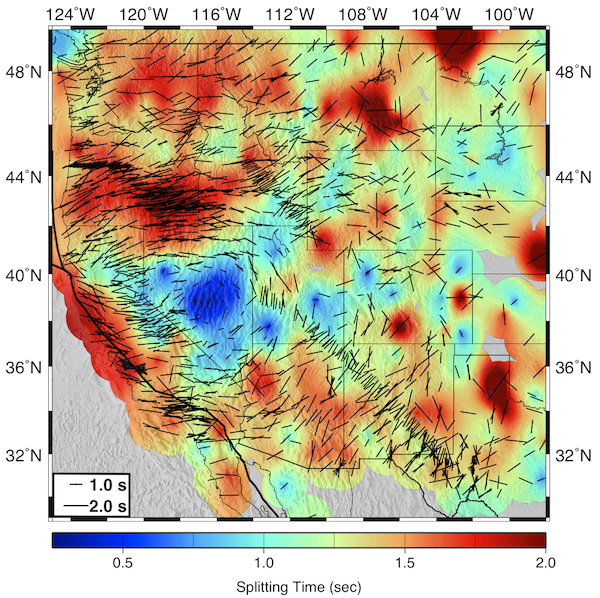2012 IRIS Workshop
The Mantle Flow Field Beneath Western North America
Matthew J. Fouch: Department of Terrestrial Magnetism, Carnegie Institution of Washington; John D. West: School of Earth and Space Exploration, Arizona State University
Published and new preliminary shear wave splitting measurements for the western half of the U.S. Bar azimuth denotes fast direction, bar length is proportional to splitting time, background is gridded splitting time. Data are consistent with a model of strong regional asthenospheric flow comprising slab rollback-driven toroidal flow (Zandt & Humphreys 2008), downwelling beneath Nevada (West et al. 2009) and a shift to the east where lithospheric structure dominates splitting in cratonic regions.

Full-resolution graphics file in original format: 0092.ai
Results from shear wave splitting analyses from a number of regional studies and over 2,500 new measurements from over 1,000 stations in the western half of North America, primarily enabled by EarthScope’s USArray. Several stations in the eastern portion of this figure have only one measurement at this time, so the details of the splitting measurements in those areas should be interpreted with caution. To first order, we interpret broad regions of higher splitting times (red areas) as well-organized and/or simple lateral mantle flow, and broad regions of smaller splitting times (blue areas) as poorly organized and/or vertical flow. These new data support a model where asthenospheric flow is the primary source of anisotropy in tectonic North America, while lithospheric anisotropy dominates in cratonic North America. The regional mantle flow field beneath western North America appears to be driven by significant and recent changes in plate boundary geometry and slab behavior. Assuming a North American plate reference frame, mantle flow appears to be controlled by rapid westward trench rollback of the Juan de Fuca plate in the Pacific NW U.S. and the opening of the Farallon slab window, and elsewhere by broader-scale mantle wind driven by either the overriding plate or large-scale mantle density anomalies. At the transition between these drivers, mantle flows strongly eastward S of the Juan de Fuca plate and generates toroidal flow around the Great Basin (e.g., Zandt and Humphreys, 2008). The only broad area of limited shear wave splitting is the Great Basin. This result, combined with several other lines of geological and geophysical evidence, is consistent with a model of strong mantle downwelling in the region (West et al., 2009). Lithospheric fabric likely contributes more significantly to the weaker splitting signal beneath cratonic North America where the lithosphere is thicker and highly variable (e.g., Schmandt and Humphreys, 2010).
Acknoweldgements: Financial support for this work came from National Science Foundation grant EAR-0548288 (MJF EarthScope CAREER grant) and the Carnegie Institution of Washington’s Department of Terrestrial Magnetism.
Keywords: seismic_anisotropy, shear_wave_splitting, lithosphere, asthenosphere
